
Manneken Pis is a landmark 55.5 cm (21.9 in) bronze fountain sculpture in central Brussels, Belgium, depicting a puer mingens; a naked little boy urinating into the fountain's basin. Though its existence is attested as early as the mid-15th century, it was redesigned by the Brabantine sculptor Jérôme Duquesnoy the Elder and put in place in 1618 or 1619. Its stone niche in rocaille style dates from 1770.
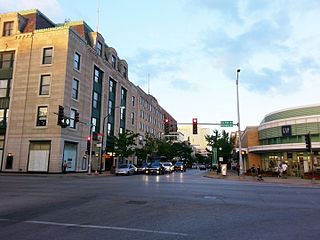
Oak Park is a village in Cook County, Illinois, adjacent to Chicago. It is the 26th-most populous municipality in Illinois, with a population of 54,583 as of the 2020 U.S. Census estimate. Oak Park was first settled in 1835 and later incorporated in 1902, when it separated from Cicero. It is closely tied to the smaller town of River Forest, sharing Oak Park and River Forest High School. Architect Frank Lloyd Wright and his wife settled in Oak Park in 1889, and his work heavily influenced local architecture and design, including the Frank Lloyd Wright Home and Studio. Over the years, rapid development was spurred by railroads and streetcars connecting the village to jobs in nearby Chicago. In 1968, Oak Park passed the Open Housing Ordinance, which helped devise strategies to integrate the village rather than resegregate.
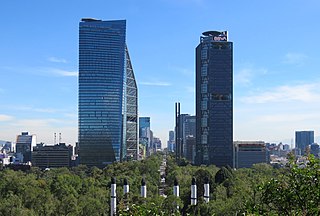
Paseo de la Reforma is a wide avenue that runs diagonally across the heart of Mexico City. It was designed at the behest of Emperor Maximilian by Ferdinand von Rosenzweig during the era of the Second Mexican Empire and modeled after the great boulevards of Europe, such as the Ringstraße in Vienna and the Champs-Élysées in Paris. The planned grand avenue was to link the National Palace with the imperial residence, Chapultepec Castle, which was then on the southwestern edge of town. The project was originally named Paseo de la Emperatriz in honor of Maximilian's consort Empress Carlota. After the fall of the Empire and Maximilian's subsequent execution, the Restored Republic renamed the Paseo in honor of the La Reforma.

Fort Koshkonong was a military fort located near the present-day city of Fort Atkinson, Wisconsin. Intended to control the confluence of the Bark and Rock rivers, it was used as a station for local militia units and the U.S. regulars in the region to scout the British Band, a group of Native Americans who fought against government units during the 1832 Black Hawk War. General Henry Atkinson was the commander of the fort during the war. Black Hawk was in the same general area, but evaded capture and started to flee towards the Wisconsin River. The original fort was abandoned by the Army following the conflict. Local settlers dismantled it for the wood as the town developed.

The Public Garden, also known as Boston Public Garden, is a large park in the heart of Boston, Massachusetts, adjacent to Boston Common. It is a part of the Emerald Necklace system of parks, and is bounded by Charles Street and Boston Common to the east, Beacon Street and Beacon Hill to the north, Arlington Street and Back Bay to the west, and Boylston Street to the south. The Public Garden was the first public botanical garden in America.
Richard W. Bock was an American sculptor and associate of Frank Lloyd Wright.
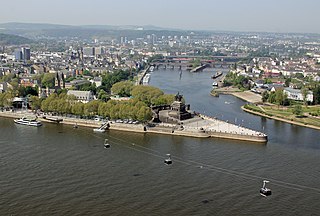
Deutsches Eck is the name of a promontory in Koblenz, Germany, where the Mosel river joins the Rhine. Named after a local commandry of the Teutonic Order, it became known for a monumental equestrian statue of William I, first German Emperor, erected in 1897 in appreciation of his role in the unification of Germany. One of many Emperor William monuments raised in the Prussian Rhine Province, it was destroyed in World War II and only the plinth was preserved as a memorial. Following German reunification, a replica of the statue was erected on the pedestal after controversial discussions in 1993. It is today a Koblenz monument and a popular tourist attraction.

The Horse Show Fountain, also known as the Wright-Bock Fountain, is located in the Chicago suburb of Oak Park, Illinois, United States. The fountain, first erected in 1909, has been widely attributed to both sculptor Richard Bock and architect Frank Lloyd Wright. Though the fountain currently stands at the corner of Oak Park Avenue and Lake Street within Scoville Park, neither the fountain nor the location is original. Its original location was 100 ft from its present location, and the fountain was completely reconstructed in 1969 to replace the badly deteriorated original. The 4.6-acre (19,000 m2) Scoville Park is listed as a historic district in the U.S. National Register of Historic Places, but the fountain – because it is a replica – is considered a non-contributing property to the listing.
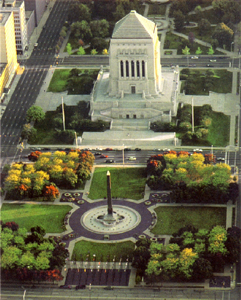
The Indiana World War Memorial Plaza is an urban feature and war memorial located in downtown Indianapolis, Indiana, United States, originally built to honor the veterans of World War I. It was conceived in 1919 as a location for the national headquarters of the American Legion and a memorial to the state's and nation's veterans.

A temperance fountain was a fountain that was set up, usually by a private benefactor, to encourage temperance, and to make abstinence from beer possible by the provision of clean, safe, and free water. Beer was the main alternative to water, and generally safer. The temperance societies had no real alternative as tea and coffee were too expensive, so drinking fountains were very attractive.

Lincoln Park is an urban park in Jersey City, New Jersey with an area of 273.4 acres (110.6 ha). Part of the Hudson County Park System, it opened in 1905 and was originally known as West Side Park. The park was designed by Daniel W. Langton and Charles N. Lowrie, both founding members of the American Society of Landscape Architects.

The Masonic Temple Building is a historic Prairie-style building in Oak Park, Illinois, at the corner of Oak Park Avenue and Lake Street. It is in the Ridgeland-Oak Park Historic District and was individually listed on the National Register of Historic Places in 1982.
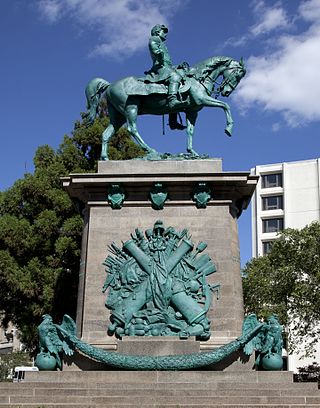
Major General George B. McClellan is an equestrian statue in Washington, D.C. that honors politician and Civil War general George B. McClellan. The monument is sited on a prominent location in the Kalorama Triangle neighborhood due to efforts made by area residents. The statue was sculpted by American artist Frederick William MacMonnies, a graduate of the École des Beaux-Arts whose best known work is a statue of Nathan Hale in New York City. MacMonnies was chosen to design the statue following a lengthy competition organized by a statue commission, led by then Secretary of War William Howard Taft. The monument was dedicated in 1907, with prominent attendees at the ceremony including President Theodore Roosevelt, New York City mayor George B. McClellan Jr., politicians, generals and thousands of military personnel.

The Ideal Scout, also known as The Boy Scout, is the most famous work by Canadian sculptor R. Tait McKenzie (1867–1938). The original statue stood in front of the Cradle of Liberty Council at 22nd and Winter Streets in Philadelphia, Pennsylvania, from 1937 to 2013. Replicas can be found at Boy Scouts of America councils across the United States, as well as at Gilwell Park in London, England, and at Scouts Canada's national office in Ottawa. The Smithsonian American Art Museum's database lists 18 copies.

Joseph Pasquale Pollia was an Italian-born American sculptor who created numerous monuments and war memorials.

Gore Park is a town square or urban park located in downtown Hamilton, Ontario.
James Salvatore John Novelli was an Italian American sculptor known for his funeral and war memorials.



















